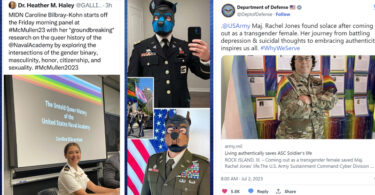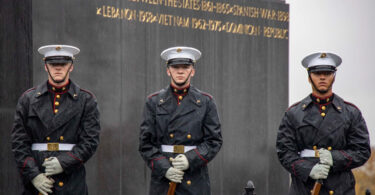By Capt. Charles “Cully” Stimson, US Navy JAG Corps, ret | Daily Signal
Can the United States Naval Academy (USNA) continue to use race in admissions decisions, even though the U.S. Supreme Court expressly forbade the use of race in college admissions last year in Students for Fair Admissions v. Harvard and Students for Fair Admissions v. UNC?
I believe the clear answer is no, as I have argued in a forthcoming law review article. The Supreme Court’s holding should apply to all the military service academies.
But that’s the issue being litigated at trial before a federal district court judge in Baltimore this week. That’s because the military service academies were not parties to the lawsuits against Harvard and the University of North Carolina, and not subject to the ruling from last year. So, it’s an open legal question.
In this first of three opinion editorials, I will discuss the legal arguments of the plaintiffs and the defendants. The second will discuss the written and oral testimony of the plaintiff’s expert witness. And the third will discuss the government’s written and oral expert presentation.
No matter which side prevails at trial, the losing side will, no doubt, appeal.
Background
The military service academies, which include the U.S. Naval Academy, the U.S. Military Academy (frequently referred to as West Point), and the U.S. Air Force Academy produce only 18% of all officers in the uniformed services. The bulk of military officers enter the service either via a Reserve Officer Training Corps (ROTC) program at their college or university or through a direct commissioning program.
Once on active duty, all officers are assigned tasks and are eligible for promotion based on their comparative performance. Graduates of the military service academies do not have a “leg up” on non-academy graduates in terms of promotion or job placement.
In the Navy, 60% of senior officers are non-Naval Academy graduates. I received a direct commission as an officer in the Navy in 1992, and retired as a captain in 2022 after 30 years of service on active duty and the reserves.
And since the U.S. Supreme Court’s holding in Students for Fair Admissions applied to all colleges and universities (with the exception, for now anyway, of the service academies), and they can no longer use race in admissions, college students in ROTC and direct-commissioning programs are not products of race-based admissions programs.
Today, 82% of all military officers receive their commission from ROTC or direct commissioning programs.
The Plaintiff’s Arguments
Students for Fair Admissions (SFFA) is a voluntary membership organization formed for “the purpose of defending human rights and civil liberties, including the right of individuals to equal protection under the law.” They are represented in this case by the law firm of Consovoy McCarthy.
Two members of SFFA are the aggrieved parties. Both are 23 years of age. One member is white and the other is Asian. Each secured a nomination from his congressman but was denied admission to the U.S. Naval Academy (USNA). They, and others similarly situated, want to apply again, but won’t unless the USNA is prohibited from using race in the admissions process, as they believe they were discriminated against because of their race.
The legal arguments by SFFA are straightforward.
After recounting the holding in the Supreme Court’s decision in Harvard/UNC cases, the plaintiffs argued in their written brief that the USNA has violated their clients’ constitutional right to equal protection under the 14th Amendment by using race during the admissions process.
They contend that the USNA’s “overt racial preferences” throughout the admissions process are not narrowly tailored to further a compelling government interest, and as such, do not satisfy the strict scrutiny standard that courts must apply in such cases.
In support of their argument, SFFA notes that the academy’s “focus on race plays out across all areas of its admissions policy,” and that the “magnitude of those racial preferences is stunning.” They note that a Diversity Task Force created by the Chief of Naval Operations in 2020 recommended that the Navy deemphasize “the use of standardized academic tests” in order to “improve minority representation” in the officer corps to “reflect relevant national demographic percentages.”
And even though the USNA denies the use of actual quotas, the plaintiffs point out the uncanny year-over-year demographics of the incoming classes to show that they are indeed involved, at the very least, in racial balancing.
For the class of 2025, the USNA enrolled 1,183 midshipmen, 672 of whom were white, 79 of whom were black, and 115 of whom were Asian. For the class of 2026, the USNA enrolled 1,184 midshipmen, 676 of whom were white, 75 of whom were black, and 117 of whom were Asian.
According to a Government Accountability Office report on race and admissions at the USNA, “the Academy makes offers of appointment to the majority of qualified minorities to achieve the Chief of Naval Operations commissioning goals for minorities.”
If that isn’t government-speak for a quota, it’s hard to see what is.
According to SFFA’s complaint, racial preferences are “determinative for hundreds of applicants each year.” And because “skin color can be – and often is – a decisive factor for successful applicants … race is a ‘positive’ factor for some Academy applicants, it is [also] a ‘negative’ factor for others.”
This “positive” versus “negative” factor language is key, as it is one of the prongs of the legal analysis in the Supreme Court’s decision finding that Harvard and UNC violated the Equal Protection Clause of the 14th Amendment.
The overall goal of the Academy’s racial balancing is to make sure that the student body “reflects our country” and reflects “the racial composition of its enlisted corps,” according to SFFA. That “goal is tantamount to a declaration that the Academy will never stop using race in admissions,” since the demographic makeup of society and the enlisted force is “constantly changing.”
This utopian quest for “statistical parity going forward” lacks “a logical end point,” quoting from Chief Justice John Roberts’ majority opinion in Students for Fair Admissions. The lack of a logical end for the use of race in admissions by colleges and universities was a major factor in the court’s decision to end the use of race in admissions.
The plaintiffs characterize the USNA’s reasons for using race in admissions into two propositions: (1) that racial preferences enhance the military’s internal functioning and military readiness, and; (2) that racial preferences enhance the military’s functional capacity by fostering internal confidence within the ranks and bolster external legitimacy, which increases societal trust and recruitment efforts.
SFFA rejects both arguments, calling them “naked appeals to deference.” They argued that the USNA views “sailors and Marines primarily as members of racial groups, rather than individuals.” The underlying “assumption of the Academy’s argument is that sailors view their peers and superiors foremost in terms of race, rather than in terms of their ability or character traits like loyalty, devotion, or selflessness.”
As to the USNA’s claim that statistical parity between the officer corps and enlisted corps is necessary to “foster trust between the enlisted corps and its leaders,” SFFA argues that the USNA “has never provided evidence to support that assertion, and indeed, all available evidence says otherwise.”
SFFA argued that there are “reams of evidence showing that trust between sailors at sea or Marines on the battlefield is formed through performance, and that servicemembers in war zones are more concerned with the leaders’ competency than with their skin color.”
They likewise rejected the USNA’s argument that racial preferences make Navy units “more effective at accomplishing their missions,” noting that there is no evidence to support that claim.
With respect to the USNA’s arguments that an officer corps must reflect the makeup of the general population and the enlisted ranks or else suffer from “external legitimacy” and a lack of “societal trust,” SFFA argues “that notion is both un-American and devoid of any evidentiary support.”
The USNA asserts that if they could not use racial preferences in admissions, it would harm their recruiting efforts.
SFFA notes, however, that even at the “apex of the Academy’s use of racial preferences,” the Navy is suffering from a recruiting crisis that is “unprecedented” in modern times, thus undercutting the academy’s recruiting argument. One of the major reasons junior officers are leaving the military, according to in-depth surveys, is that “non-merit factors in admissions and promotions” has infected the officer corps.
To drive the point home, SFFA notes that nine out of 10 respondents to these surveys said that “more officers would stay [in] if the military was more of a meritocracy.”
The USNA’s Arguments
At the outset, the USNA admits that it uses race and ethnicity as a factor in the admissions process, but that it does so in a way that is both constitutional and narrowly tailored to achieve a compelling government interest.
The government asserts that the “military’s interest in building a diverse officer corps is integral to ensuring national security.” The government claim that the quest for a diverse officer corps is “both distinct and measurable,” in “stark contrast to the universities’ admissions policies at issue in [the Harvard/UNC cases].”
The USNA argues that its use of race in admissions is “narrowly tailored,” that it treats each “candidate as an individual,” that its use of race is a “nondeterminative factors,” that the process is “holistic,” that “race is not used as a negative” or part of a quota. As such, there is “no available, workable alternative.”
The USNA’s arguments are unpersuasive and circular.
The USNA notes, without irony, that of the five steps in the admissions process, “at four limited parts of the admissions process, USNA may consider race or ethnicity.” In other words, in 80% of the admissions process, the USNA uses races to inform its admissions decision.
First, race or ethnicity can be a factor in deciding whether to send a potential candidate a “letter of assurance” for admission to the academy.
Second, board members who evaluate candidates to the USNA use a score called the “Whole Person Multiple” (WPM). Race or ethnicity can be a factor where the highest WPM scores are very close, yet the USNA decides to select a “slightly lower WPM … over the qualified candidate with a slightly higher WPM after an in-depth review of their entire record.” The USNA asserts that the use of race or ethnicity in these circumstances is only one of many “nondeterminative factors” that “inform” its decisions.
Third, the head of the USNA (called the superintendent) may nominate up to 50 candidates in any given year. Race or ethnicity can be one of the factors considered by the superintendent.
Fourth, if the USNA has not reached its authorized class size by the end of the admissions process, the academy may consider race or ethnicity “in extending offers to additional appointees.”
The USNA asserts that although “military interests” do not “always trump other considerations,” courts have given great deference “to the professional judgment of military authorities concerning the relative importance of a particular military interest.”
The government asserts four reasons why a diverse officer corps is vital to the national security of the United States.
First, it fosters cohesion and lethality. Second, it aids in the recruitment of top talent. Third, diversity increases retention. And fourth, diversity in the officer corps “bolsters its legitimacy in the eyes of the nation and the world.”
The USNA asserts that those reasons, and the goal of diversity in the officer corps, are subject to meaningful judicial review. The claim that a court can examine whether race riots have occurred since the Navy made an effort to diversify their officer corps. A court should also “carefully consider” the views of senior military leadership, who opine that achieving diversity is a national security imperative.
Third, a court should examine feedback from current servicemembers’ surveys about the importance of unit cohesion and command climate. And finally, a court can examine the “demographic data” to determine whether the Navy “officer corps reflects the diversity of the nation as a whole.”
The USNA claims that it “seriously considered race-neutral alternatives,” but that “there currently are not available, workable alternatives that would suffice to produce the benefits of a diverse Navy officer corps.” The USNA claims to have increased outreach, marketing, added extra points to candidates from low socio-economic backgrounds, prioritized first-generation status, and even considered changing or eliminating standardized test scores.
The USNA asserts that it does not intend to use race and ethnicity as a factor in its admissions process indefinitely. It recognizes that there must be an “end point,” but then fails to identify any such end point in its brief before the court.
My Take
The USNA uses races and ethnicity in its admissions process. That violates the Equal Protection Clause of the 14th Amendment, unless USNA’s use of these factors is narrowly tailored to achieve a compelling government interest.
The compelling government interest the USNA claims is that national security demands that the United States have a racially and ethnically diverse officer corps. Its briefs artfully avoid the fact that the service academies as a whole only produce 18% of the officer corps in the United States military, and that 60% of senior officers in the U.S. Navy did not graduate from the USNA.
The academy does not argue, must less show, why a college that produces a statistical minority of officers to the entire U.S. military and a minority of senior officers in the Navy must use race in its admissions, or how doing so bolsters the national security interests of the United States.
The government’s brief does not argue, nor could it with any credibility, that graduates of the military service academies are better officers than officers produced via ROTC or direct commissioning programs. The latter two of which, since they are college-based or college graduates, are barred from using race in its college admission decisions.
Noticeably absent from the academy’s brief is the argument that the Court’s decision in Students for Fair Admissions has weakened the national security of the country since colleges and universities across the country are now forbidden from using race in admissions.
The government’s claim that the USNA’s use of race and ethnicity in the admissions process is nondeterminative and narrowly tailored is belied by the fact that race and ethnicity is used in four of the five steps in the admissions process.
Finally, the academy’s two-paragraph argument that it does not intend to use race and ethnicity indefinitely is wholly unpersuasive, when read in the context of its entire brief. If, as the academy claims, it’s important to have an officer corps that reflects the “diversity of the nation as a whole,” and the demographics of the nation are constantly changing (which they are), then there is no logical end point at which the USNA will stop tweaking the composition of the officer corps at the academy by race.
_
Charles “Cully” Stimson is the deputy director of the Edwin Meese III Center for Legal and Judicial Studies, the manager of the National Security Law Program, a senior legal fellow, and a senior advisor to the president at The Heritage Foundation. A third-generation naval officer, Cully served in the Navy Judge Advocate General’s Corps (JAG) for 30 years, including three tours on active duty. During his active duty and reserve career, he served as a military defense counsel, prosecutor, as Deputy Chief Judge of the Navy-Marine Corps Trial Judiciary, and the Commanding Officer of the Preliminary Hearing Unit among other assignments. He retired from the Navy JAG Corps as a Captain on February 1, 2022, after 30 years of service. Read his bio and research.








Leave a Comment